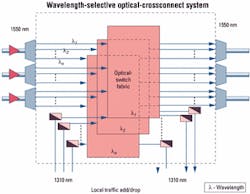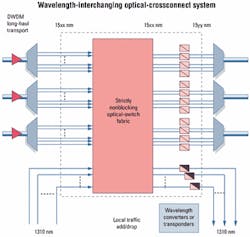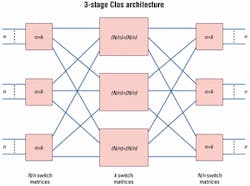Building optical-switch fabrics using 2-D and 3-D MEMS platforms
Which implementation is the best choice for your network architecture and its applications?
DR. MENG-HSIUNG KIANG, Onix Microsystems Inc.
Optical technology advances were the key driver behind the widespread deployment of fiber links in long-haul transport networks. DWDM technology, of course, dramatically enhanced the scalability of the existing networks by increasing the capacity of point-to-point connections. It does not address the need to manage bandwidth more efficiently, however.
Optical-crossconnect (OXC) switches, also known as wavelength routers, promise to fulfill this need. The basic function of an OXC switch is to allow flexible reconfiguration of the connections at the wavelength level by users on a remote location. Central to this system is a switching fabric that enables the redirection of the optical signals traversing the network nodes. Most of the OXC switches used in today's networks utilize electronic-switching fabrics. The use of electronic-switching fabrics allows for regeneration to eliminate signal impairments, subwavelength channel grooming, and aggregation. The drawbacks with the electronic fabrics are the difficulty to scale to higher port counts and the large amount of power and floor space these systems consume.
Many in the industry now believe pure electronic-switching-fabric-based OXC systems do not offer an efficient solution for next-generation networks. A "hybrid" OXC that uses the combination of an electronic-switching fabric for sub-line-rate traffic grooming and an optical switching fabric for "express traffic" management has emerged as the preferred solution for the near future. A major challenge, however, is to develop all-optical switching fabrics that can provide the necessary economics and scalability beyond what is achievable by electronic means. To win acceptance among service providers, these optical-switching fabrics must demonstrate extremely high reliability to meet the high-availability requirements of communication applications.
Various optical technologies have been investigated as candidates for building all-optical switching fabrics. While some of these technologies are already being commercialized in low port-count (2-32-channel) switch configurations, most products cannot be extended much beyond their current forms. Common limitations of these technologies are relatively high optical insertion losses and crosstalk.
Silicon micromachining, commonly referred to as micro-electromechanical systems (MEMS), is the technology expected by many to emerge as the leader for building optical-switching devices. Silicon MEMS technology uses processing steps derived from IC fabrication techniques of photolithography, material deposition, and chemical etching to produce movable mechanical structures on a silicon chip. The batch-processed nature of the fabrication procedure means that MEMS devices can be mass-produced on a large scale, which reduces manufacturing costs. In addition, the extremely small physical sizes and masses of these silicon parts (e.g., micro-mirrors) often make them more robust and capable of faster operation than conventional macroscopic mechanical devices.
The key element in a MEMS optical switch is a two-dimensional matrix of micro-machined mirrors, fabricated in single-crystal or polycrystalline silicon or other materials, which are used to make reconfigurable optical connections between input and output fiber arrays or matrices. There are two major technology platforms for MEMS-based optical switches.
In the first implementation, a two-dimensional (2-D) NxN mirror matrix combined with linear input and output fiber arrays is used to form an NxN crossbar switch-thus the term 2-D switches. Control signals applied to the MEMS chip set the position of each individual mirror to either pass or intersect the input light beams, directing each incoming light signal to the desired output port. Because the intersecting micro-mirrors must direct the outgoing light beams into the output fiber ports, tight control of the mirror angles is vital to minimizing the optical signal attenuation and insertion-loss variation incurred from passing through the switch. The optical quality of the micro-mirrors contributes to the absolute level and uniformity of the optical performance. Using the right technology and design, extremely low insertion loss and crosstalk can be achieved by this architecture, enabling compact optical-switch modules with up to 32x32 input and output ports.Alternatively, the same NxN switch functionality can be achieved using 2N mirrors, each with N controllable positions. This approach, often referred to as the "analog" or "three-dimensional (3-D)" architecture, is used to construct large all-optical switching fabrics within a single switch stage. Because the micro-mirrors are precision controlled by closed-loop servo electronics, this implementation can produce switches with lower insertion loss than that of the 2-D platform. Furthermore, as the number of ports in the switches increases, the benefit of using significantly fewer mirrors becomes dramatic as it improves the manufacturing yield of the MEMS wafers.
On the other hand, the added complexity in optical packaging and electronic design inherent in the 3-D architecture makes it a less appealing solution for applications that require smaller port-count (<32) optical switches.
To facilitate end-to-end network management, carriers have begun to deploy OXC switches in their higher-density route nodes. These large facilities typically interconnect multiple fiber conduits housing a large number of cables. With the number of DWDM wavelengths carried on each fiber growing beyond 100, the total number of ports needed in an OXC system ranges from hundreds to thousands. Several architectures for these OXC systems have been proposed and studied extensively.
A well-known commercial implementation is the wavelength-selective OXC. In a wavelength-selective OXC system, different channels are separated into individual wavelength planes for traffic reconfiguration. As shown in Figure 1, the number of input and output ports needed for the optical-switching fabric corresponds roughly to the fibers being managed by a particular system. The number of optical-switch-fabric units used per system scales proportionately to the number of DWDM channels carried on each fiber.
A major architectural advantage of a wavelength-selective OXC is capacity expansion. Carriers tend to add DWDM channels to existing fiber rather than pull new fiber through the facility; wavelength-selective OXCs allow carriers to grow network capacity as demand increases.
On the other hand, this architecture does not allow arbitrary crossconnections of different wavelengths, making it a switching system with finite blocking probabilities. Given the relatively small (<40) number of fibers connected by these systems, a 2-D MEMS-based optical-switching platform is the preferred technology for developing these systems. The network equipment vendors select the appropriate optical-switching components based on the size of the facilities their systems are designed for, typically ranging from 4x4 to 16x16 for 4- to 16-fiber facilities at this time. In the initial system configuration, the number of optical-switch units corresponds to the number of wavelength channels used at the time of the deployment. After that, the service providers can expand their bandwidth capacity in service with additional optical-switch cards and DWDM line cards for just-in-time growth of their networks.A wavelength-selective OXC system is an indispensable network element for building full-fledged optical transport networks. Working in conjunction with DWDM systems, it provides optical wavelength-level grooming and dynamic optical add/drop multiplexing functionalities, enabling remote management of the network end-to-end. Other applications of wavelength-selective OXC systems include wavelength-channel-based service protection and restoration using a line, ring, or mesh-based network architecture, allowing more flexible network designs for the diverse needs of different carriers.
Another common OXC implementation used in central offices is a wavelength-interchanging system (see Figure 2). In this system, the dimension of the optical-switching fabric is the same as the total port count requirements of the OXC. Wavelength-interchanging OXC systems are truly nonblocking, allowing any wavelength path on any fiber to be rerouted onto any other fiber. The potential problem of wavelength contention in so doing is resolved by converting the output wavelengths into appropriate new colors based on specific routing algorithms. Two options exist for the construction of a large-port-count optical-switching core. One approach is to build a single-stage switching fabric with the corresponding number of ports needed for the system. This architecture is most suitable for 3-D MEMS switching fabrics, given its ability to scale. The other option is to use cascaded smaller-port-count switches in a multistage configuration.
One commonly employed multistage design is the three-stage Clos architecture with symmetrical input and output stages. As shown in Figure 3, an NxN fully nonblocking optical-switching fabric is constructed by using (N/n) number of nxk matrix switches in the first and third stage, with k units of (N/n)x(N/n) matrix switches used in the second stage of the fabric. Setting k=2n-1 to satisfy the requirement for strictly nonblocking condition, the optimized configuration (i.e., with minimized crosspoint through the switch fabric) calls for:A specific example helps to illustrate this point.
To construct a 128x128 optical-switching fabric requires the use of 16 8x15 optical switches for the first and last stages, respectively, and 15 16x16 switches for the middle stage. As a result, 47 switch matrices in total are needed to complete this architecture. Even if the system designers choose to combine the first and third stages by sharing 16x16 switch matrices as two halves-each as an 8x16 switch-it still requires 31 16x16 switch units to complete one fabric. Potential penalties of this approach include reduced system reliability and difficulty during repair, as the result of sharing components for the input and output stages.
The advantage of using a multistage approach is in the modularity offered by the constituent switch matrices within a switch fabric. The smaller individual switch elements, typically with dimensions in the range of 2-D MEMS switch fabrics, are more reliable and easier to manufacture than one large switch fabric. Although only limited quantities have been shipped to date, 2-D MEMS optical-switching components have been available since last year. More vendors are likely to enter this market with additional products in the near future. As vendors and system integrators go through more qualification tests with these products, it will help us to better understand and establish confidence in the reliability of 2-D MEMS-based switching components.
The commercial availability of larger-port-count switching fabrics based on a 3-D MEMS platform is further out on the horizon, which means that measurable reliability data for these products will not be available for some time to come.The use of a multistage architecture allows for built-in redundancies that provide additional paths to reroute the optical signals within the switch fabric. In the case of the three-stage 128x128 optical switch, using 16x16 2-D MEMS switch matrices throughout the fabric corresponds to providing 1:15 protection for each internal light path. It is estimated that this approach offers more than a five-fold improvement in the availability of the entire system.* The relative availability of a large-port-count optical-switching fabric based on 2-D MEMS and 3-D MEMS platforms is not readily predictable because very limited reliability data for either of the two schemes exists today.
Meanwhile, using a single-stage architecture to construct an optical-switching fabric is desirable for several reasons. The total system cost is one: the aggregated switch component cost using multistage designs can grow dramatically as the number of port counts increase. In the case of the 128x128 optical-switching fabric, for the multistage solution to be cost-competitive-assuming 31 16x16 switches are used-still requires that the per-port price for the 16x16 2-D MEMS switch is about 1/4 that of the 128x128 3-D MEMS switch fabric. Furthermore, cascading the smaller switch matrices into a multistage fabric means additional labor and material costs for interconnecting fiber splicing or connectorization. At some point, such tasks can become very time-consuming or even intractable. Furthermore, fiber splices and connectors introduce a finite amount of excess throughput loss and can turn individual component repair and replacement into complicated maintenance operations.
With a multistage approach, more stringent optical performance requirements and constraints may be placed on 2-D-based technologies. For instance, to fulfill a same-design target of 6-dB excess loss through the entire optical-switch fabric, the multistage solution would need to incur less than 2-dB insertion loss per switch element, which is difficult for a 16x16 matrix switch as the technology stands today. If fiber connectors are used to interconnect the individual switch elements within the fabric, the result is further erosion in the insertion loss and reliability margins. A 6-dB insertion loss target for a 128x128 3-D MEMS switching fabric is much more likely to be achieved.
Finally, as the pressure on carriers to reduce network operating expenses mounts, bandwidth demands continue to grow. Networking solutions that can support flexible bandwidth services will allow providers to develop new revenue streams and realize faster returns on investment.
As optical technology advances, the vision of intelligent optical networks is becoming a reality. All-optical switching fabrics, particularly MEMS optical switches, will serve as key enablers of these ultra-high-bandwidth optical communications networks. The decision of whether to build these systems using 2-D or 3-D MEMS technology platforms will depend on customers' specific network architectures. In situations where both multistage and single-stage architectures are candidates for addressing the same application, cost, performance, reliability, and product availability will determine the final selection.
Dr. Meng-Hsiung Kiang is co-founder of Onix Microsystems Inc. (Richmond, CA) and the company's director of business development and product management.
L. Wosinska, L. Thylen, and R.P. Holm strom, "Large Capacity Strictly Non blocking Optical Cross-Connects Based on MEMS Switch Matrices: Reliability Performance Analysis," IEEE J. Lightwave Technology, Vol. 19, No. 8, pp. 1065-1075, 2001.




